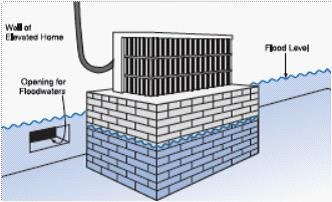6 Ways to Flood Proof
Unexpected and sudden storms can cause serious flood damage to your property and possessions. Property Owners who take steps to retrofit their home or business in anticipation of uncertain weather, come out ahead.
Relocation

Moving your home or structure out of the floodplain to higher ground where it will not be exposed to flooding.
Demolition
Tearing down your damaged structure and either rebuilding on the same property outside the floodplain or buying a building or home/business elsewhere.
Dry Floodproofing
Sealing your structure to prevent floodwaters from entering (see illustration #1). Some examples of dry floodproofing include the installation of watertight shields for windows and doors; use of sealants and membranes to reduce seepage of floodwaters through walls; reinforcement of walls to withstand the pressures from floodwaters. Note that FEMA does not allow dry floodproofing for new or substantially improved or damaged residential structures located in the SFHA.
Wet Floodproofing

Making uninhabited portions of your structure resistant to flood damage by allowing water to enter during flooding (see illustration #2). Effective wet floodproofing entails that the floodwaters enter and exit the home; damage to areas of the home that are located below the flood level are reduced from contact with the floodwaters; service equipment is protected from the floodwaters both inside and outside the residence. The use of flood vents, flood damage resistant building materials, and protecting service equipment by locating them above the anticipated flood elevation are all methods of wet floodproofing.
Floodwalls
Building a wall around your structure to hold back floodwaters. (This requires review and approval by SEMSWA before starting work – see Working in the Floodplain for more information). Construction of a flood walls will not remove a structure from the FEMA Flood Insurance Rate Maps (FIRM).
Elevation

Elevation of the structure is permitted and required when an existing structure in the floodplain is substantially damaged or substantially improved. Elevation is raising your home/structure so that the lowest floor is 2 feet above the flood level. In addition, the footprint of the elevated structure cannot be increased. Mechanical equipment will also have to be elevated, as outlined in illustration #3.
Keep in mind that only elevation, relocation, and demolition can be used to meet the minimum requirements of FEMA (i.e. will result in the building being removed from the floodplain). The other methods may be used to minimize damages but are not recognized as meeting the minimum requirements of FEMA (i.e. the building will remain as shown in the floodplain and flood insurance may still be required). Remember that it is important to purchase flood insurance for your home, even if you mitigate your home using one of these methods.
